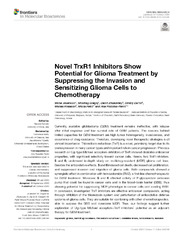Приказ основних података о документу
Novel TrxR1 Inhibitors Show Potential for Glioma Treatment by Suppressing the Invasion and Sensitizing Glioma Cells to Chemotherapy
| dc.creator | Jovanović, Mirna | |
| dc.creator | Dragoj, Miodrag | |
| dc.creator | Zhukovsky, Daniil | |
| dc.creator | Dar’in, Dmitry | |
| dc.creator | Krasavin, Mikhail | |
| dc.creator | Pešić, Milica | |
| dc.creator | Podolski-Renić, Ana | |
| dc.date.accessioned | 2020-10-30T09:13:14Z | |
| dc.date.available | 2020-10-30T09:13:14Z | |
| dc.date.issued | 2020 | |
| dc.identifier.issn | 2296-889X | |
| dc.identifier.uri | https://www.frontiersin.org/article/10.3389/fmolb.2020.586146/full | |
| dc.identifier.uri | https://radar.ibiss.bg.ac.rs/handle/123456789/3944 | |
| dc.description.abstract | Currently available glioblastoma (GBM) treatment remains ineffective, with relapse after initial response and low survival rate of GBM patients. Reasons behind limited capacities for GBM treatment are high tumor heterogeneity, invasiveness and occurrence of drug resistance. Therefore, developing novel therapeutic strategies is of utmost importance. Thioredoxin reductase (TrxR) is a novel, promising target due to its overexpression in many cancer types and important role in cancer progression. Previous research on Ugi-type Michael acceptors– inhibitors of TrxR, showed desirable anticancer properties, with significant selectivity towards cancer cells. Herein, two TrxR inhibitors, 5 and 6 underwent in depth study on multidrug resistant (MDR) glioma cell lines. Besides antioxidative effect, 5 and 6 induced cell death, decreased cell proliferation, suppressed invasion and migration of glioma cells. Both compounds showed a synergistic effect in combination with temozolomide (TMZ), a first line chemotherapeutic for GBM treatment. Moreover, 5 and 6 affected the activity of P-glycoprotein extrusion pump that could be found on cancer cells and in blood-brain barrier (BBB), thus showing potential for suppressing MDR phenotype in cancer cells and evading BBB. In conclusion, investigated TrxR inhibitors are effective anticancer compounds, acting through inhibition of thioredoxin system and perturbation of antioxidative defense systems of glioma cells. They are suitable for combining with other chemotherapeutics, able to surpass the BBB and overcome MDR. Thus our findings suggest further exploration of Ugi-type Michael acceptors-TrxR inhibitors’ potential as adjuvant therapy for GBM treatment. | en |
| dc.publisher | Frontiers Media SA | |
| dc.relation | info:eu-repo/grantAgreement/MESTD/inst-2020/200007/RS// | |
| dc.relation | ERA.Net RUS plus joint program (THIOREDIN) | |
| dc.rights | openAccess | |
| dc.rights.uri | https://creativecommons.org/licenses/by/4.0/ | |
| dc.source | Frontiers in Molecular Biosciences | |
| dc.subject | Glioma | |
| dc.subject | Invasion | |
| dc.subject | Multidrug resistance | |
| dc.subject | Oxidative stress | |
| dc.subject | Temozolomide | |
| dc.subject | Thioredoxin reductase 1 | |
| dc.title | Novel TrxR1 Inhibitors Show Potential for Glioma Treatment by Suppressing the Invasion and Sensitizing Glioma Cells to Chemotherapy | en |
| dc.type | article | en |
| dc.rights.license | BY | |
| dcterms.abstract | Дар’ин, Дмитрy; Јовановић, Мирна; Зхуковскy, Даниил; Подолски-Ренић, Aна; Красавин, Микхаил; Драгој, Миодраг; Пешић, Милица; | |
| dc.rights.holder | © 2020 Jovanović, Dragoj, Zhukovsky, Dar’in, Krasavin, Pešić and Podolski-Renić. | |
| dc.citation.volume | 7 | |
| dc.identifier.doi | 10.3389/fmolb.2020.586146 | |
| dc.identifier.scopus | 2-s2.0-85093518423 | |
| dc.identifier.wos | 000579474800001 | |
| dc.citation.apa | Jovanović, M., Dragoj, M., Zhukovsky, D., Dar’in, D., Krasavin, M., Pešić, M., et al. (2020). Novel TrxR1 Inhibitors Show Potential for Glioma Treatment by Suppressing the Invasion and Sensitizing Glioma Cells to Chemotherapy. Frontiers in Molecular Biosciences, 7, 281. | |
| dc.citation.vancouver | Jovanović M, Dragoj M, Zhukovsky D, Dar’in D, Krasavin M, Pešić M, Podolski-Renić A. Novel TrxR1 Inhibitors Show Potential for Glioma Treatment by Suppressing the Invasion and Sensitizing Glioma Cells to Chemotherapy. Front Mol Biosci. 2020;7:281. | |
| dc.citation.spage | 281 | |
| dc.type.version | publishedVersion | |
| dc.identifier.fulltext | https://radar.ibiss.bg.ac.rs/bitstream/id/7540/fmolb-07-586146.pdf | |
| dc.citation.rank | M21 |

